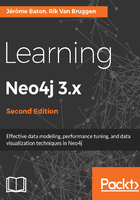
Relational databases
Relational Database Management Systems are probably the ones that we are most familiar with in 21st century computer science. Some of the history behind the creation of these databases is quite interesting. It started with an unknown researcher at IBM's San Jose, CA, research facility--a gentleman called Edgar Codd. Mr. Codd was working at IBM on hard disk research projects, but was increasingly drawn into the navigational database management systems world that would be using these hard disks. Mr. Codd became increasingly frustrated with these systems, mostly with their lack of an intuitive query interface.
Essentially, you could store data in a network/hierarchy, but how would you ever get it back out?

Codd wrote several papers on a different approach to database management systems that would not rely as much on linked lists of data (networks or hierarchies) but more on sets of data. He proved--using a mathematical representation called tuple calculus--that sets would be able to adhere to the same requirements that navigational database management systems were implementing. The only requirement was that there would be a proper query language that would ensure some of the consistency requirements on the database. This, then, became the inspiration for declarative query languages such as Structured Query Language (SQL). IBM's System R was one of the first implementations of such a system, but Software Development Laboratories, a small company founded by ex-IBM people and one illustrious Mr. Larry Ellison, actually beat IBM to the market. Their product, Oracle, never got released until a couple of years later by Relational Software, Inc., and then eventually became the flagship software product of Oracle Corporation, which we all know today.
With relational databases came a process that all of us who have studied computer science know as normalization. This is the process that database modellers go through to minimize database redundancy and introduce disk storage savings, by introducing dependency. It involves splitting off data elements that appear more than once in a relational database table into their own table structures. Instead of storing the city where a person lives as a property of the person record, I would split the city into a separate table structure and store person entities in one table and city entities in another table. By doing so, we will often be creating the need to join these tables back together at query time. Depending on the cardinality of the relationship between these different tables (1:many, many:1, and many:many), this would require the introduction of a new type of table to execute these join operations: the join table, which links together two tables that would normally have a many:many cardinality.
I think it is safe to say that Relational Database Management Systems have served our industry extremely well in the past 30 years and will probably continue to do so for a very long time to come. However, they also came with a couple of issues, which are interesting to point out as they will (again) set the stage for another generation of database management systems:
- Relational Database Systems suffer at scale. As the sets or tables of the relational systems grow longer, the query response times of the relational database systems generally get worse, much worse. For most use cases, this was and is not necessarily a problem, but as we all know, size does matter, and this deficiency certainly does harm the relational model. A counter example to this could be Google's Spanner, a scalable, multi-version, globally-distributed, and synchronously-replicated database.
- Relational Databases are quite anti-relational; they are less relational than graph databases. As the domains of our applications--and therefore, the relational models that represent those domains--become more complex, relational systems really start to become very difficult to work with. More specifically, join operations, where users would ask queries of the database that would pull data from a number of different sets/tables, are extremely complicated and resource-intensive for the database management system. There is a true limit to the number of join operations that such a system can effectively perform, before the join bombs go off and the system becomes very unresponsive. See an example of explosive model.

- Relational databases impose a schema even before we put any data into the database and even if a schema is too rigid. Many of us work in domains where it is very difficult to apply a single database schema to all the elements of the domain that we are working with. Increasingly, we are seeing the need for a flexible type of schema that would cater to a more iterative, more agile way of developing software.
As you will see in the following sections, the next generation of database management systems is definitely not settling for what we have today, and is attempting to push innovation forward by providing solutions to some of these extremely complex problems.